Hyundai
Elantra Rear Brake Pads Replacement Guide
How to change the rear disc brake pads on
a sixth generation 2017, 2018, 2019 and 2020 Hyundai Elantra sedan.
By Paul B. Michaels Author & Photographer Auto Mechanic Since 1989 |
||
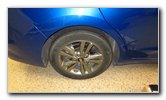 2018 Elantra Rear Wheel |
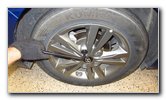 Slightly Loosen Lug Nuts |
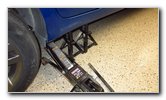 Raise Rear of Vehicle |
| This automotive
maintenance tutorial was specifically written to assist owners of the 6th
generation (2017, 2018, 2019, 2020 and most likely also the upcoming 2021 model
year) Hyundai Elantra sedan in changing the rear disc brake pads,
lubricating the caliper slider pins and also replacing the rotors if
necessary. Owners of other Hyundai, Genesis or Kia vehicles such as the Sonata, Accent, Veloster, Ioniq, Kona, Nexo, Venue, Tucson, Santa Fe, Palisade, G70, G80, G90, Soul, Sportage, Niro, Sorento, Telluride, Rio, Forte, Optima, Stinger, Cadenza, K900, Sedona and Seltos may also find these DIY instructions to be helpful. A few compatible replacement sets of new rear brake pads with their numbers are as follows: Power Stop 16-1313, Callahan CPK11282, Raybestos EHT1812H and Bendix SBC1812. The tools and other items needed to complete this procedure include a lug nut wrench, a floor jack, two jack stands, a 14mm socket with a 3/8" drive ratchet, a 14mm wrench, a Lisle 28600 disc brake piston tool with a short extension bar and a tube of brake caliper grease. The first few steps are to drive the car on to a level surface, shift the transmission into "Park" and turn off the ignition. Make sure that the emergency / parking brake has been released. If the parking brake is not released, you will not be able to pull the rear caliper out of the bracket and off the old pads. Place wheel chocks on both sides of the front tires to prevent the car from moving. I recommend firmly tapping the wheel chocks under the front tires with a rubber mallet to keep the vehicle securely in place. Slightly loosen the five lug nuts by turning them about 1/4 to 1/2 turn in the counterclockwise direction with the tire iron. Then raise the rear of the car with the floor jack and securely support it with at least two jack stands. Please do not solely rely on the floor jack to support the vehicle. I prefer to only work on one side of the car at a time to keep three tires on the ground for extra safety. |
||
|
|
||
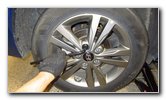 Spin Off Five Lug Nuts |
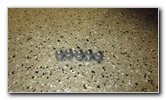 5 Lug Nuts Removed |
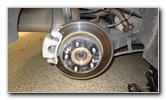 Caliper, Bracket, Rotor |
| Spin off the five
lug nuts in the counterclockwise direction. Set the lug nuts aside in a safe place. Carefully remove the rear wheel and tire to reveal the caliper, bracket, rotor and suspension. |
||
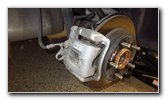 Rear Brake Caliper |
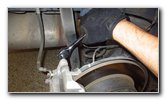 Loosen Top Caliper Bolt |
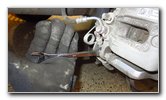 Loosen Bottom Bolt |
| The rear brake
caliper is held in place to the bracket by two bolts situated on the back
side of the caliper. The two bolt heads face in towards the trunk. Loosen the top caliper bolt by turning it in the clockwise direction (as seen from the outside of the vehicle) with the 14mm socket and a 3/8" drive ratchet. Then loosen the bottom caliper bolt by turning it in the clockwise direction (when viewed from the outside of the car). I had trouble fitting my socket and ratchet over the bottom caliper bolt due to the traditional cable operated parking brake mechanism being in the way. So I instead had to use a small 14mm wrench to loosen the bottom bolt. |
||
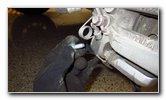 Spin Out Lower Bolt |
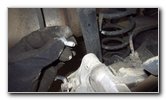 Remove Upper Bolt |
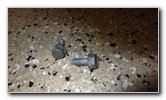 2 Caliper Bolts Removed |
| Spin out the two
bolts the rest of the way by hand. Set the two bolts aside in a safe place. |
||
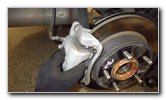 Lift Caliper Off Pads |
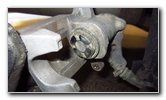 Screw-In Type Piston |
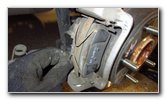 "V" Metal Spring Clips |
| Carefully lift the
rear caliper out of the bracket and off the old brake pads. Try to avoid bending, kinking or stressing the rubber brake fluid hose. This 2018 Elantra is equipped with a "screw-in" type rear caliper piston that will need to be turned back in order to retract it. (If your Elantra has an electronic parking brake or "EPB", you may need an OBD2 Scanner that specifically has the ability to place the EPB into "service" or "maintenance" mode.) Pull the two "V" shaped metal spring clips off the outer edge of the old brake pads. These are the drag reduction clips (also known as the friction reduction clips or "pad spreading springs"). They help improve fuel economy by keeping the pads from touching the rotor when the brakes are not applied. If your new set of rear brake pads does not include replacement spring clips, set aside the old ones for re-installation later on. |
||
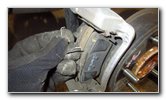 Detach Two Spring Clips |
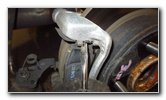 Push In Metal Tab |
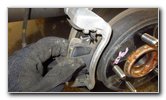 Remove Old Outer Pad |
| Pull the old inner
and outer brake pads out of the bracket. You may need to use a flat head screwdriver to push in the metal tabs on the pad abutment clips if they prevent you from pulling out the old pads. |
||
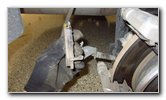 Wear Bar - Bottom Inner |
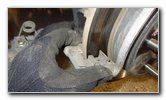 Pad Abutment Clip |
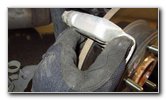 Replace Top Clip |
| Make a mental note
of where the wear indicator bar or "squeal bar" is situated on the old brake
pads. On this 2018 Elantra, the wear indicator bar was located at the bottom of the inner brake pad. If your new set of rear pads includes a bag of replacement hardware, pull the old pad abutment or "anti-rattle" clips out of the top and bottom of the bracket. Clean off the rotor, bracket, caliper and lug studs with brake parts cleaner spray. Try to avoid breathing in the brake dust or the cleaning spray since they may be carcinogenic (cancer causing). Apply some brake parts lubricant grease to the top and bottom of the new pad abutment clips where they will come in contact with the bracket or the new pads. Avoid getting grease on to the friction surface of the new pads or the rotor. Push the new pad abutment clips into the top and bottom of the bracket until they are fully seated. |
||
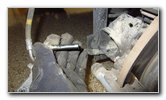 Caliper Slider Pins |
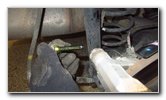 Lubricate & Replace Pins |
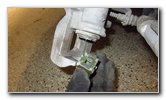 Disc Brake Piston Tool |
| In order for the
caliper to operate smoothly, the two caliper slider pins or "guide bolts"
need to be well lubricated. Do not mix up the top and bottom slider pins since they are slightly different. Pull one pin out at a time, apply a thin layer of brake caliper grease to the smooth parts and then push it back into the rubber dust boot. Repeat the process for the other caliper slider pin. Test fit the various sides of the Lisle 28600 disc brake piston tool to see which side has the best grip on the screw-in type caliper piston. Attach the piston tool to a short extension bar and the 3/8" drive ratchet. |
||
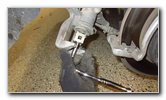 Rotate Back Piston |
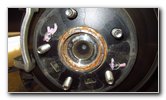 Two Rotor Set Screws |
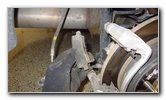 Wear Bar @ Bottom Inner |
| Slowly turn back
the piston in the clockwise direction to retract it.
Continue retracting the piston until it is just about flush with the rubber dust boot that surrounds it. If your Elantra has been exhibiting shuddering, shaking or vibrations in the rear end while braking, the OEM rotors might be warped and should be replaced. A few compatible replacement rear rotors with their part numbers are as follows: DuraGo BR901100-02, Raybestos 980957R and ACDelco 18A2853A. To replace the rear rotors, remove the two 14mm bolts on the back side of the bracket and remove the bracket. Remove the two set screws on the outer face of the rotor by turning them in the counterclockwise direction with a Phillips head screwdriver. Slide the old rotor off the wheel hub. If you have trouble removing a stubborn stuck rotor, hit it with a rubber mallet to loosen the rust. Slide the new rotor over the lug studs and replace the two Phillips head set screws. Replace the bracket and tighten the two 14mm bolts in the clockwise direction. The torque specification in the shop manual for the bracket bolts is a range of 47.0 to 54.2 lb-ft of torque. |
||
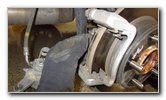 Install New Inner Pad |
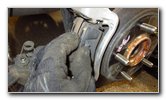 Install New Outer Pad |
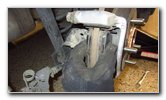 Push Pads Against Rotor |
| Install the new
inner and outer brake pads into the bracket. The wear indicator bar should be situated at the bottom of the inner brake pad. Push the two pads together until they are flush against the rotor. |
||
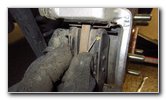 Replace Top Spring Clip |
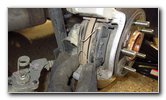 Re-Attach Lower Clip |
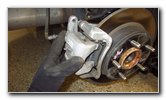 Lower Caliper Over Pads |
| If your new brake
pads are equipped with the small holes on the outer edges, re-attach the two
"V" shaped metal drag reduction clips. Carefully lower the caliper into the bracket and over the new brake pads. Line up the bolt holes in the caliper with their corresponding holes in the slider pins attached to the bracket. |
||
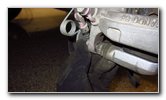 Spin In Lower Bolt |
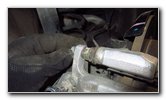 Spin In Upper Bolt |
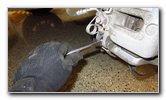 Tighten Bottom Bolt |
| Spin in the two caliper bolts a few turns by hand in the counterclockwise direction (as seen when viewed from the outside of the car) to help prevent them from becoming cross threaded. | ||
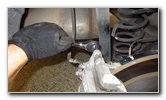 Tighten Top Caliper Bolt |
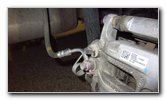 Rubber Valve Cap |
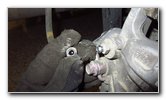 Brake Fluid Bleeder |
| Tighten the two
bolts in the counterclockwise direction (as seen from the outside of the
car) with the 14mm socket and a 3/8" drive ratchet or the 14mm wrench. The service manual torque specification for the rear caliper bolts is a range of 15.9 to 23.1 lb-ft. Double check that the two caliper bolts are tight before moving on to the next steps. If your brake pedal feels soft or spongy, you may need to bleed the brake lines in order to remove any air bubbles or moisture. Check out my Acura MDX Brake Fluid Bleeding Guide for more information on this procedure. In general, you will bleed the brake lines from the furthest wheel from the brake fluid reservoir to the closest one. The brake fluid bleeder valve is located just below the top caliper bolt. You'll need a 10mm wrench to open and close the bleeder valve. |
||
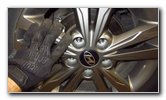 Replace Rear Wheel |
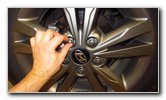 Spin On Five Lug Nuts |
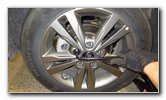 Slightly Tighten Lug Nuts |
| Carefully push the
rear wheel and tire back into place over the lug studs. Spin on the five lug nuts a few turns by hand in the clockwise direction to help prevent them from becoming cross threaded. Slightly tighten the lug nuts with the tire iron in a "criss-cross" or "star" pattern. |
||
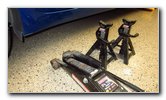 Lower Car From Stands |
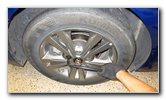 Torque Lug Nuts |
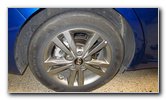 Rear Brake Job Done! |
| Carefully lower the
vehicle from the jack stands by using the floor jack. Continue tightening the five lug nuts in a "star" pattern to about 1/8th of a turn past hand tight. It would be best to use a torque wrench to properly tighten the lug nuts to the owner's manual specification of 79 to 94 lb-ft. Please double check your owner's manual to verify the lug nut torque specification for your vehicle. Don't forget to write down the brake pad change in your car's service records. For more, please check out all of my
2017-2020 Hyundai Elantra DIY Repair & Maintenance Guides. |
||
| If you found this guide to be helpful,
please consider making a small donation by clicking on the PayPal.com
"Donate" button located to the right of this paragraph. Thank you!
(Note: I am not a registered charity. Donations are not tax deductible.) |

